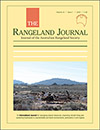
The Rangeland Journal
Volume 44 Number 1 2022
RJ21046Stocking density and distribution in relation to vegetation in a biodiverse semi-arid pastoral system in South Africa
Pastoral mobility is key to managing livestock and rangeland resources in the most plant diverse desert in the world. Here, forage availability varies and Nama pastoralists in South Africa need to match this variability by moving their herds to different vegetation types in the rangeland. This results in some vegetation types being overstocked whereas others are left ungrazed by livestock. Policies on rangeland management should acknowledge this variability and not recommend fixed and similar stocking rates for all vegetation types.
RJ21046 Abstract | RJ21046 Full Text | RJ21046PDF (2.3 MB) | RJ21046Supplementary Material (489 KB) Open Access Article
RJ21034Response of species abundance distribution pattern of alpine meadow community to sampling scales
(1) Protecting global biodiversity is the eternal theme of human pursuit. (2) Species abundance distribution (SAD) is an important community structure pattern, and refers to the number of species in a community. Niche differentiation is the mechanism and main ecological process of the formation of abundance pattern in alpine meadow. (3) The study has established a framework to understand mechanism and ecological process of SADs formation with sampling scaling, aiming to improve the conservation and management of alpine meadow ecosystem.
The increase of trees in rangelands negatively affects grass availability for livestock and wild animals. In this study, we reduced the number of trees in the field to increase grass production. We found that tree removal does not guarantee increased grasses for livestock in all rangelands; however, it may improve tree growth. In conclusion, we have shown that regardless of the substantial investments accompanying the application of tree management in rangelands, the grass layer may not recover.
RJ21003 Abstract | RJ21003 Full Text | RJ21003PDF (1.1 MB) | RJ21003Supplementary Material (504 KB) Open Access Article
RJ21053Responses of grass productivity traits to bush clearing in semi-arid rangelands in North-West Province of South Africa
Bush control is a management tool used to restore herbaceous biomass production to increase rangelandgrazing capacity. Assessment of grass productivity traits, e.g. tiller and leaf production responses to bush control, is key to derive fine-detailed management. Bush control increased tiller, leaf and biomass production of most bunch grasses, indicating that bush control can be used as a tool to combat bush encroachment and increase forage production.
RJ21053 Abstract | RJ21053 Full Text | RJ21053PDF (2 MB) | RJ21053Supplementary Material (168 KB) Open Access Article
Understanding forage availability is important for the management of large, vertebrate herbivores for conservation. Between 2016 and 2019 we sampled understorey biomass in semi-arid woodlands in south-eastern Australia, where regeneration has been lacking due to grazing pressure exerted by western grey kangaroos; we found that within woodlands, forage regularly dropped to critical levels in summer and autumn, even in years of average rainfall. This information can help managers prioritise areas for herbivore management and identify areas where revegetation requires additional protection.
RJ21060 Abstract | RJ21060 Full Text | RJ21060PDF (1.8 MB) | RJ21060Supplementary Material (892 KB) Open Access Article




